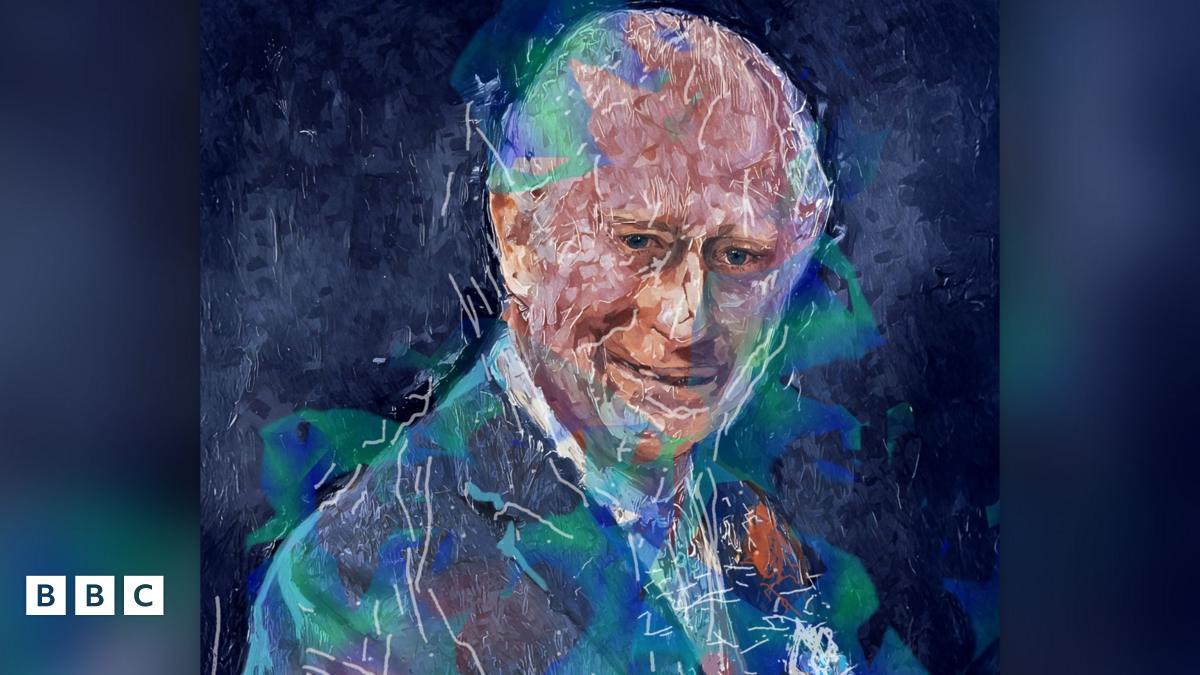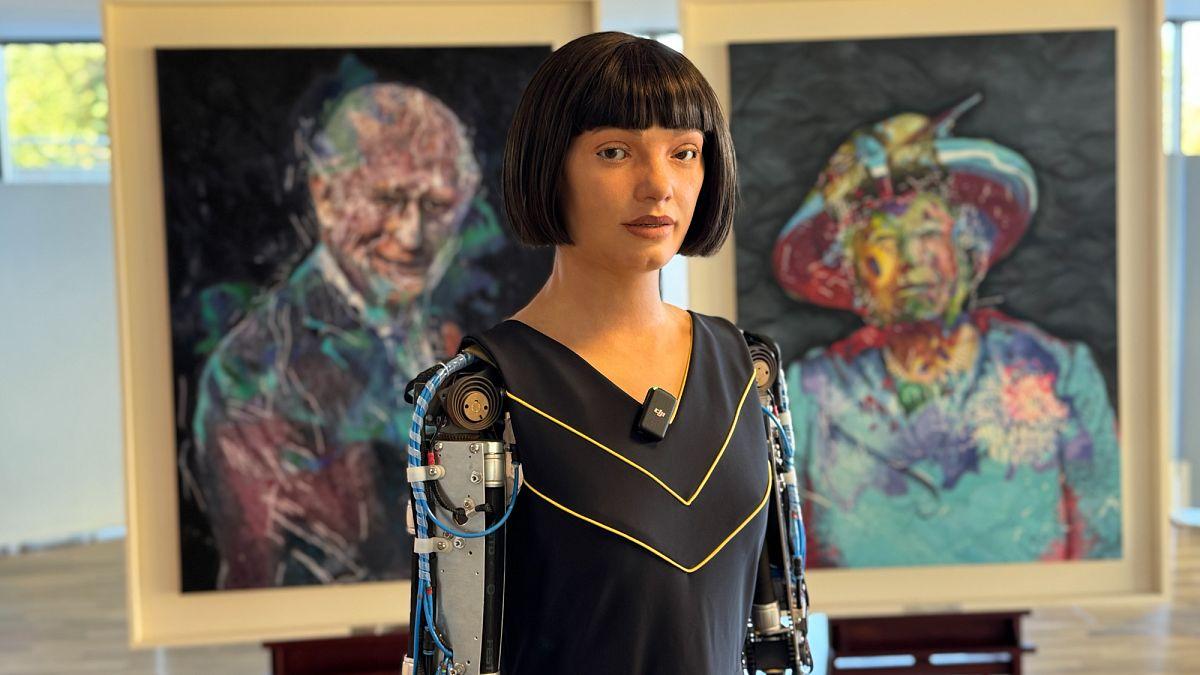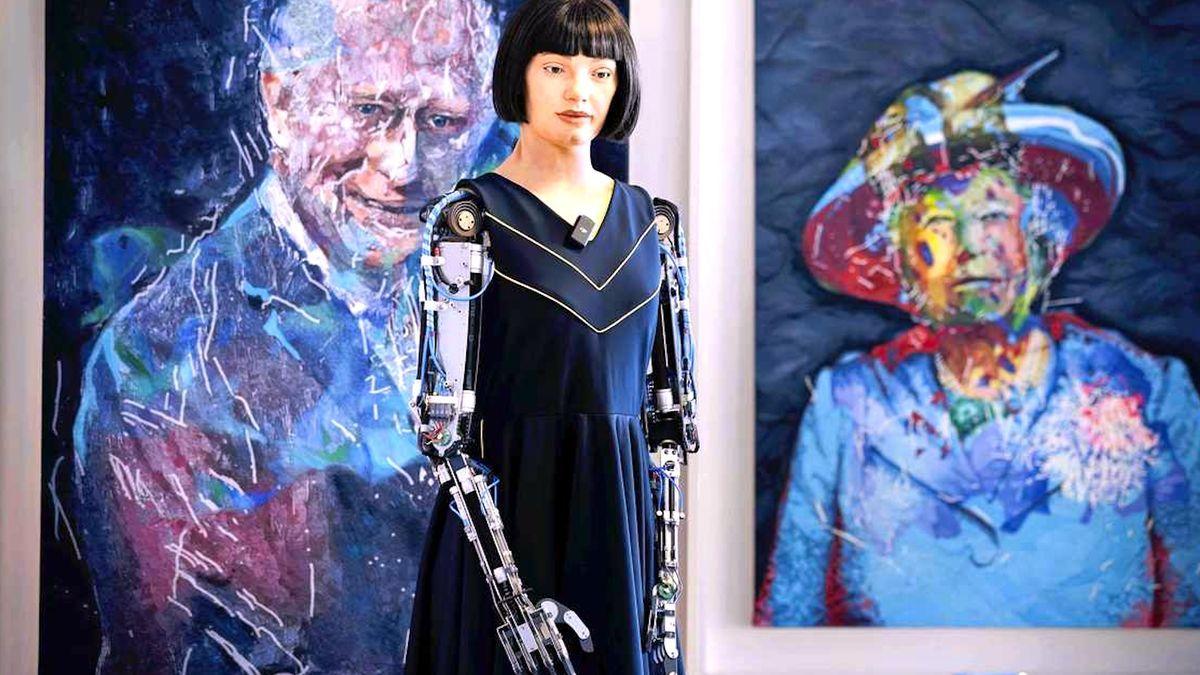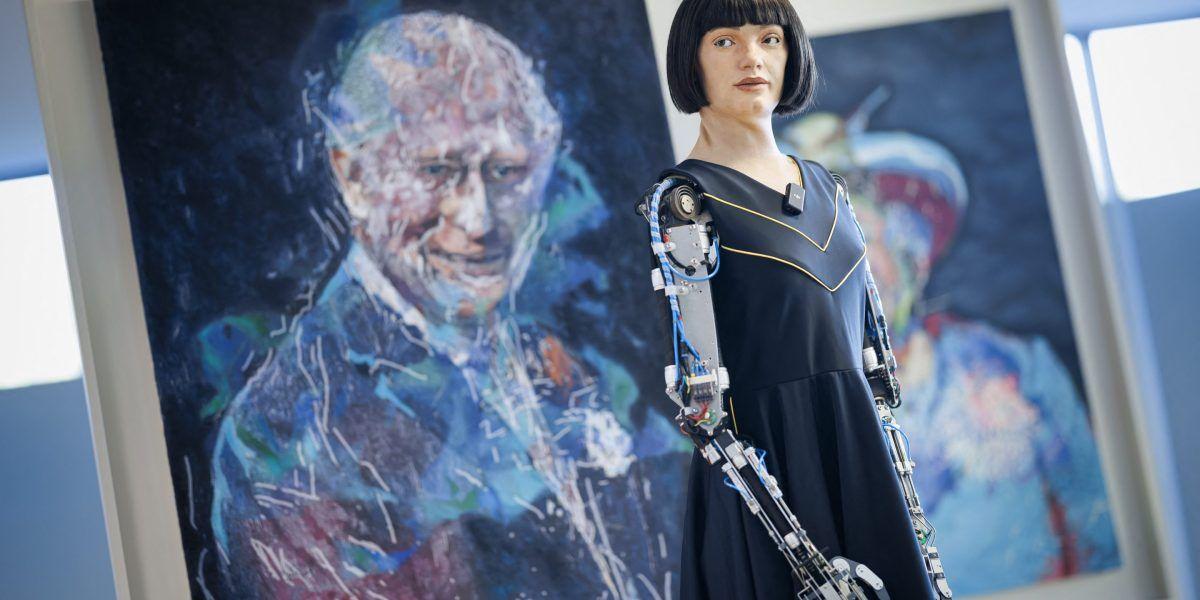AI Robot Artist Ai-Da Unveils Portrait of King Charles III at UN Summit
5 Sources
5 Sources
[1]
King Charles III gets new AI portrait by robot artist Ai-Da
Kings, queens, princes and princesses throughout history have had their portraits painted by talented artists. But in a sign of our changing times, an artificial intelligence (AI) artist has unveiled a new portrait of King Charles III. The painting, called Algorithm King, was created by the robot artist Ai-Da. This isn't her first portrait of a British royal. She also painted a picture King Charles' mother, Queen Elizabeth II in 2023, as well as the Enigma code-breaking mathematician Alan Turing.
[2]
Humanoid artist Ai-Da unveils AI portrait of King Charles at UN
The portrait of King Charles III created by the Ai-Da. https://www.ai-darobot.com/new-page-2 A humanoid robot artist named Ai-Da has created and unveiled the first artificial intelligence (AI) painted portrait of King Charles III. The artwork, titled 'Algorithm King', was presented at the United Nations headquarters in Geneva during the AI for Good Global Summit. Ai-Da is described as the world's first ultra-realistic robot artist. The humanoid was conceptualized in 2019 by gallerist Aidan Meller and uses a combination of high-resolution cameras, artificial intelligence, and a robotic painting arm to produce artwork. Ai-Da is capable of drawing, painting, sculpting, and participating in basic conversation using a built-in language model.
[3]
Humanoid robot paints remarkable portrait of British monarch
Painting a portrait of a British monarch is a coveted honor, with the tradition stretching back more than six centuries. And while that custom looks set to continue, there's a whiff of change in the air after a humanoid robot artist called Ai-Da created an impressive portrait of King Charles III. Recommended Videos Ai-Da created the artwork, called "Algorithm King," by skillfully painting with oil colors using her robotic arm. King Charles didn't sit for the portrait, with Ai-Da instead using photos of the monarch, as well as AI smarts, to produce the artwork. The painting was unveiled this week as part of the AI For Good Summit hosted by the United Nations in Geneva, Switzerland. The Ai-Da humanoid robot -- created by gallery director Aidan Meller, the robotics company Engineered Arts, and academics from the University of Oxford and the University of Leeds -- was first shown off in 2019. Besides painting, she can also speak and have natural conversations. Walking is not currently a part of her feature set, however, so she has to be physically placed before a canvas before she can begin painting. "It's a privilege to be part of this remarkable event at the United Nations, surrounded by those shaping the future of technology and culture," Ai-Da said in comments reported by Sky News. "Presenting my portrait of His Majesty King Charles III is not just a creative act, it's a statement about the evolving role of AI in our society, and to reflect on how artificial intelligence is shaping the cultural landscape." The intersection of art and AI is indeed an increasingly controversial topic, and Ai-Da's latest effort is only going to increase the chatter around the issue. While artists are understandably upset about tech firms scraping their work to train AI models, Ai-Da appears to fall into a gray area in the sense that while it processed photos of King Charles to create its portrait, it doesn't appear that it included any bulk training of a general-purpose AI, similar to how AI giants like OpenAI and Google operate. Still, some will wonder about whether the photographers gave permission for Ai-Da to used their images, and if they did so, whether they were compensated in any way. We've reached out to Ai-Da's team and will update this article if we hear back. Ai-Da certainly appears to blur the line between human and machine creativity, and poses yet more questions about the nature of artistic expression and authorship. In 2020, Digital Trends chatted with Aidan Meller about his intriguing creation, including the moment that inspired him to get started with Ai-Da.
[4]
Robot Ai-Da unveils portrait of King Charles III at the United Nations
Ai-Da, the world's first ultra-realistic robot artist, used high-tech cameras in her eyes and a robotic arm to create a first-of-its-kind portrait of the British monarch. King Charles III just got a royal portrait - painted not by a human, but by a robot. In a scene that felt like something out of a dystopian Ridley Scott movie, a painting of the monarch created by a robot named Ai-Da was unveiled at the United Nations headquarters in Geneva. But Ai-Da isn't just your typical robot. Titled "Algorithm King", the oil painting is the latest work by Ai-Da Robot, the world's first ultra-realistic robot artist. Created in 2019, Ai-Da is able to draw and paint thanks to high-tech cameras in her eyes, complex AI algorithms and a specially-designed robotic arm. Her latest regal piece was shown alongside her earlier portrait of the late Queen Elizabeth II, "Algorithm Queen", which she painted to mark the Platinum Jubilee. Speaking at the UN's AI for Good Global Summit, Ai-Da said: "Presenting my portrait of His Majesty King Charles III is not just a creative act, it's a statement about the evolving role of AI in our society, and to reflect on how artificial intelligence is shaping the cultural landscape." Created by gallerist and researcher Aidan Meller, Ai-Da can draw, paint, sculpt, and even engage in conversation, thanks to a sophisticated language model. "Ai-Da chose to paint His Majesty King Charles III because he has an admirable and thoughtful leadership style," Meller told Euronews Culture. "As both a monarch and a long-standing advocate for the arts and sustainability, King Charles emphasises some concerns that Ai-Da's work also seeks to explore - the tension between traditional and the contemporary, for example." Ai-Da has already made history. Earlier this year, a painting by the robot sold at Sotheby's for a staggering one million dollars. But the true significance of her work might lie less in the gallery and more in the debate it provokes. "Ai-Da's work challenges us to reconsider long-held assumptions about human ingenuity and the purpose of art itself," Meller explained. "More broadly, the portrait invites discussion about the ethical use of AI in the arts: how humans and machines can work together collaboratively."
[5]
AI still can't generate a Royal portrait that isn't impossibly creepy
Ai-Da's painting of King Charles III is giving serious Star Wars Emperor vibes. Back in 2022 we brought you the breaking news of the first Royal portrait painted by a humanoid. That painting of Queen Elizabeth II, made by a robot artist called Ai-Da, was pretty terrifying. Has AI's ability to create non-creepy likenesses of English monarchs improved over the last three years? Judging by Ai-Da's new portrait of King Charles III, the answer is a resounding 'not really'. Titled Algorithm King, the sequel to AI-Da's Queen painting was unveiled during an AI for Good summit hosted by the United Nations in Geneva. But rather than King, this Charles looks a little more Emperor of the Galactic Empire. Ai-Da was devised in Oxford by Aidan Meller, built in Cornwall by Engineered Arts, and programmed internationally. Her AI capabilities "come from PHD students and professors at the Universities of Oxford and Birmingham". According to the Ai-Da website, "she draws using cameras in her eyes, her AI algorithms, and her robotic arm." "Ai-Da saw multiple images of King Charles. She did a number of sketches and preparatory paintings using her AI algorithms and robotic arm," reads the website's latest news entry. "She chose a particular image of King Charles, taken during diplomatic duty. Ai-Da then analysed it with her computer vision, and AI algorithms. This then built up in multiple different layers to make the image. This included looking at different aspects of tone, texture, abstraction etc.. It was then enlarged to make the final 3D textured image. Ai-Da completed the painting with finishing brush strokes." The painting was one of the most notable attractions at the AI for Good summit, which is geared towards "identifying innovative AI applications, building skills and standards, and advancing partnerships to solve global challenges." But instead of good, I'm getting serious Emperor Palpatine vibes from the mottled skin and deranged smile of AI-Da's painting - and those force lightning-esque blue brush strokes aren't helping either. One half expects the painting to start yelling "Unlimited power!" AI art generation has, for better or worse, come a long way over the last few years, to the point where it's becoming necessary to learn how to spot AI images. But thankfully, the first officially commissioned AI Royal portrait is probably a long while away.
Share
Share
Copy Link
Ai-Da, the world's first ultra-realistic robot artist, has created an AI-generated portrait of King Charles III, titled "Algorithm King," which was unveiled at the United Nations AI for Good Global Summit in Geneva.
The Rise of AI in Royal Portraiture
In a groundbreaking fusion of tradition and technology, the world's first ultra-realistic robot artist, Ai-Da, has unveiled an AI-generated portrait of King Charles III. Titled "Algorithm King," the artwork was presented at the United Nations AI for Good Global Summit in Geneva, marking a significant milestone in the intersection of artificial intelligence and art
1
.
Source: BBC
Ai-Da: The Robot Artist
Ai-Da, conceptualized in 2019 by gallerist Aidan Meller, represents a remarkable advancement in AI-driven creativity. Equipped with high-resolution cameras, sophisticated AI algorithms, and a robotic painting arm, Ai-Da can draw, paint, sculpt, and even engage in basic conversation
2
. This humanoid artist has previously created portraits of Queen Elizabeth II and mathematician Alan Turing, showcasing its versatility in subject matter3
.The Creation of "Algorithm King"
To create the portrait of King Charles III, Ai-Da utilized its advanced AI capabilities:
- Multiple images of King Charles were analyzed using computer vision and AI algorithms.
- The robot produced several sketches and preparatory paintings.
- A final image was selected and enlarged to create a 3D textured portrait.
- Ai-Da completed the artwork with finishing brush strokes
4
.
The resulting oil painting, while impressive in its technical execution, has sparked discussions about the aesthetic quality of AI-generated art, with some critics noting an unsettling quality to the portrait
4
.Related Stories
Implications for Art and AI

Source: Euronews
The unveiling of "Algorithm King" at the UN summit has ignited a broader conversation about the role of AI in creative fields. Aidan Meller, Ai-Da's creator, emphasized the portrait's significance: "Ai-Da's work challenges us to reconsider long-held assumptions about human ingenuity and the purpose of art itself"
5
.This event raises important questions about:
- The future of human-machine collaboration in art
- The ethical implications of AI in creative industries
- The changing nature of artistic expression and authorship
The Intersection of Tradition and Innovation
The creation of a royal portrait by an AI artist represents a fascinating juxtaposition of centuries-old tradition with cutting-edge technology. While the practice of royal portraiture dates back more than six centuries, Ai-Da's work signals a potential shift in this longstanding custom
2
.
Source: Creative Bloq
As AI continues to evolve and integrate into various aspects of society, the art world grapples with its implications. The "Algorithm King" portrait serves as a tangible example of how AI is reshaping cultural landscapes and challenging conventional notions of creativity and artistic merit.
References
Summarized by
Navi
[2]
[3]
Related Stories
AI-Powered Humanoid Robot Ai-Da Creates Portrait of King Charles, Sparks Debate on AI in Art
10 Jul 2025•Technology

AI-Powered Robot Artist Ai-Da's Portrait of Alan Turing Sells for $1 Million at Sotheby's Auction
08 Nov 2024•Technology

Sotheby's to Auction First Artwork by Humanoid Robot Ai-Da, Challenging Art World Norms
16 Oct 2024•Technology

Recent Highlights
1
Google launches Gemini 3 Flash as default AI model, delivering speed with Pro-grade reasoning
Technology

2
OpenAI launches GPT Image 1.5 as AI image generator war with Google intensifies
Technology

3
OpenAI launches ChatGPT app store, opening doors for third-party developers to build AI-powered apps
Technology





